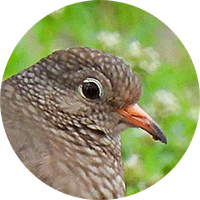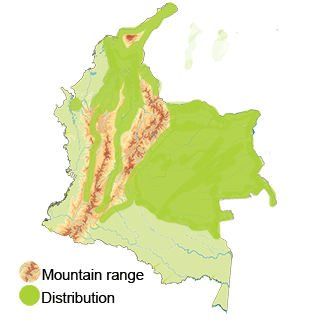Common Ground Dove
The Common Ground-dove (Columbina passerina) Read in Spanish
Appearance: The Common Ground-dove is a small, plump bird with a brownish-gray plumage on its upperparts and a pale, buff-colored underside. It has a pinkish hue on its breast and a short, rounded tail with white tips. This species displays sexual dimorphism, with males typically being slightly more colorful than females.
Habitat: Common Ground-doves inhabit a variety of open habitats such as grasslands, savannas, agricultural areas, scrublands, and forest edges. In Colombia, they can be found in lowland and mid-elevation regions, including the Llanos, the Magdalena River Valley, the Andean foothills, and parts of the Caribbean Coast.
Behavior: These doves are predominantly terrestrial and forage on the ground for seeds and grains. They are known for their soft, rhythmic cooing calls used for communication, territorial defense, and courtship. Common Ground-doves are generally shy and inconspicuous birds, often seen singly or in pairs.
Breeding: Breeding habits of Common Ground-doves involve establishing territories, courtship displays, and nest-building. They typically build flimsy nests in shrubs or trees using twigs, grasses, and leaves. The female lays 2 white eggs, and both parents share the responsibilities of incubation and caring for the young birds.
Conservation Status: The Common Ground-dove is not considered globally threatened.
Distribution
The Common Ground-dove (Columbina passerina) is a species commonly found in Colombia. It has a widespread distribution across various regions of the country. This small, terrestrial bird prefers open habitats such as grasslands, savannas, agricultural areas, and forest edges.
The Common Ground Dove can be found in both lowland and mid-elevation areas. The species occurs in regions like the Llanos (plains) in eastern Colombia, the Magdalena River Valley, the Andean foothills, and parts of the Caribbean Coast. Specific regions within Colombia where the Common Ground Dove can be observed include Antioquia, Meta, Casanare, Cundinamarca, Boyacá, Santander, Valle del Cauca, and Guajira, among others.
The Common Ground Dove's habitat preferences and food sources contribute to its distribution across varied ecosystems. This species primarily feeds on seeds and grains found on the ground, making open habitats with ample cover and water sources ideal for its survival.
Taxonomy
The Common Ground-dove (Columbina passerina)
- Kingdom: Animalia
- Phylum: Chordata
- Class: Aves
- Order: Columbiformes
- Family: Columbidae
- Genus: Columbina
- Species: Columbina passerina
Vocalization
The Common Ground-dove (Columbina passerina)
The vocalizations of Common Ground-doves are characterized by soft, melancholy coos and calls that are often monotonous but rhythmic in nature.
The most commonly heard vocalization of the Common Ground-dove is a soft "coo-coo" or "cooing" sound that is repeated at regular intervals. This call is often used by males to establish and defend their territory, attract mates, and communicate with other nearby doves. The frequency and intensity of the cooing vocalization may vary depending on the specific context, such as breeding season, territorial disputes, or interactions with other doves.
In addition to the cooing calls, Common Ground-doves may also emit a soft "whistle" or "perched coo" sound while perched or flying. These vocalizations serve various purposes, including maintaining contact with mates, signaling alarm in response to potential threats, or communicating subtle cues to other doves in the vicinity.
Overall, the vocalizations of the Common Ground-dove are essential for social interactions, territorial defense, and reproductive activities within the species. By listening to and interpreting these distinctive calls, researchers and bird enthusiasts can gain insights into the behavior and ecology of this charming bird species.





